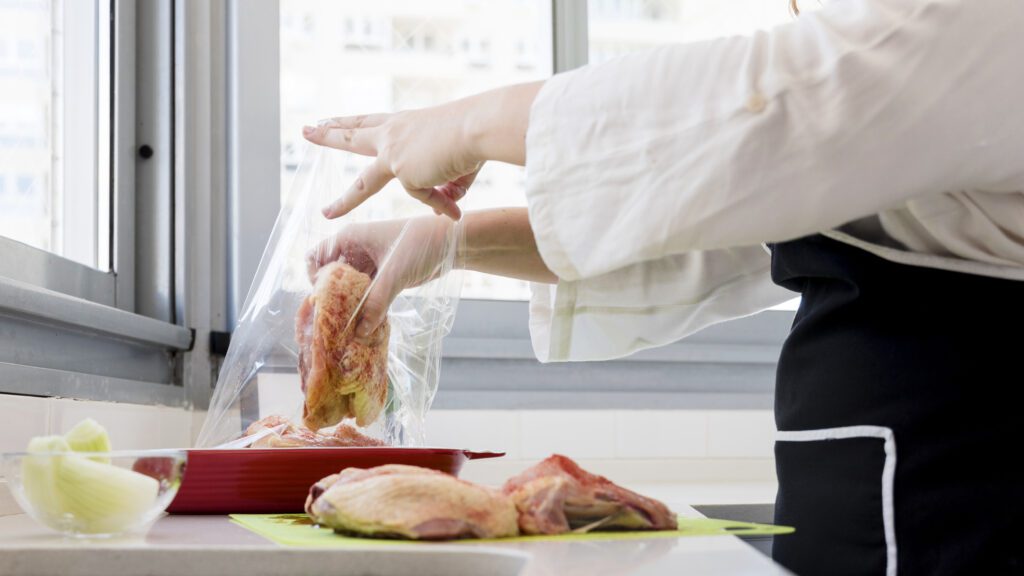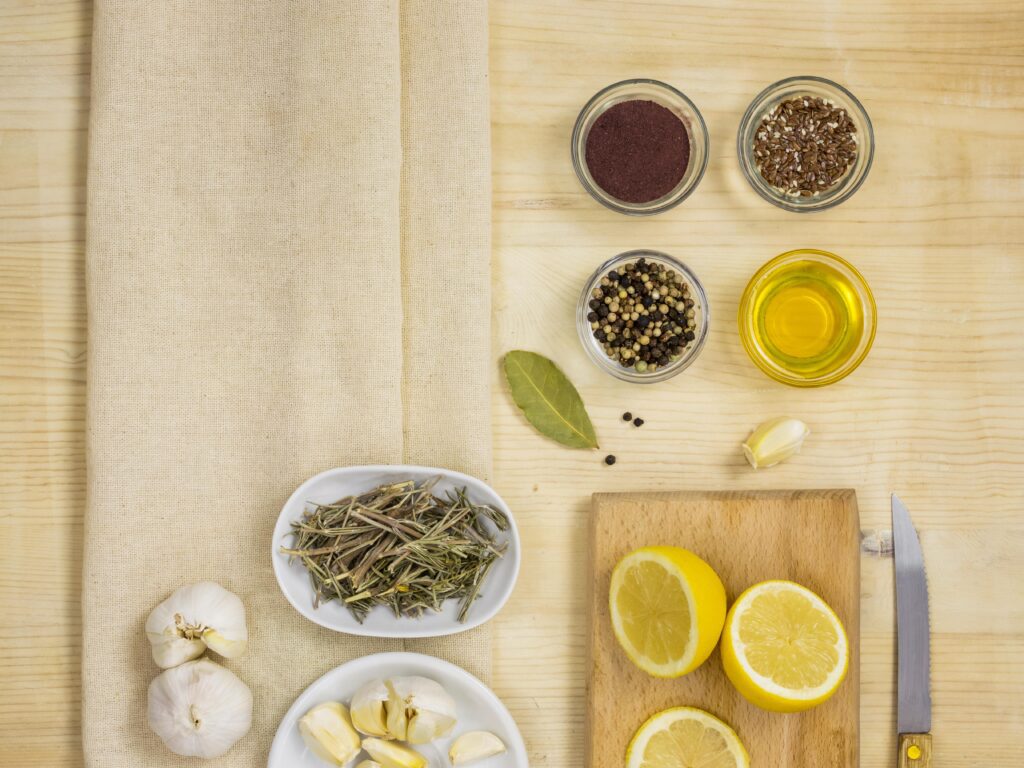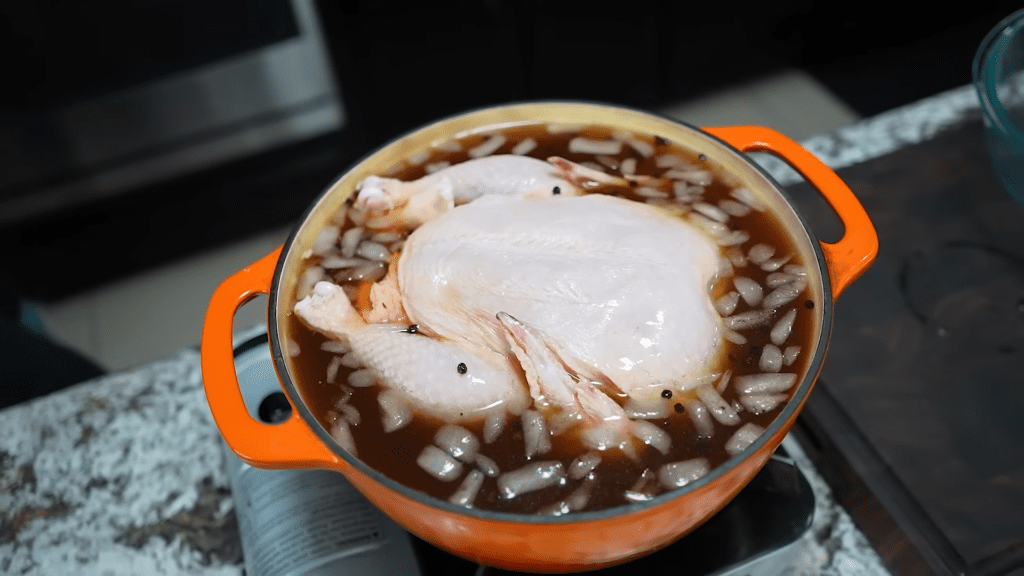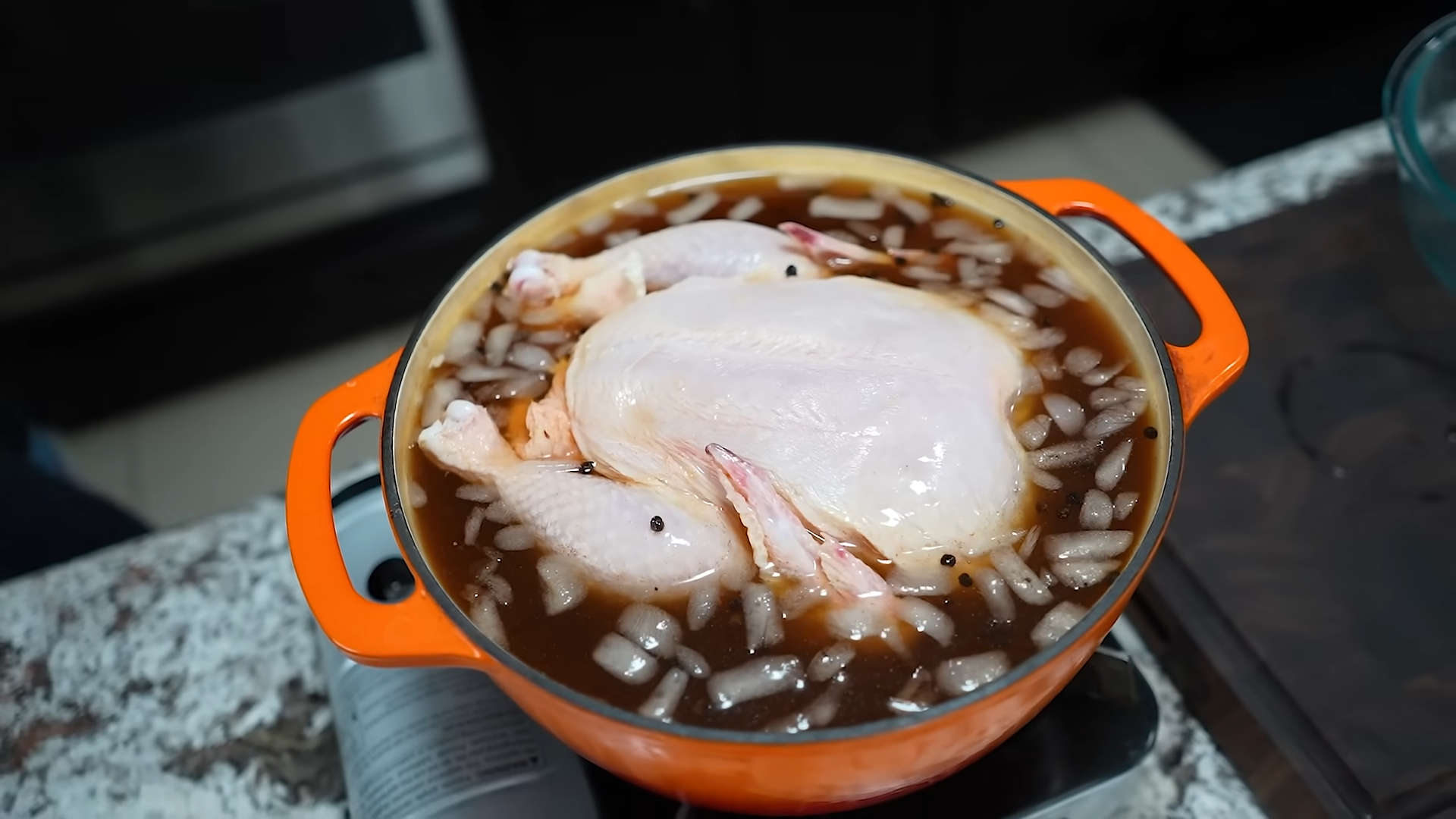Brining chicken might seem like a complicated process, but it’s actually a straightforward technique that can make a world of difference in the taste and texture of your meals. Whether you’re preparing a whole roast chicken, grilling some juicy breasts, or frying up crispy wings, brining can help you achieve that perfect, mouth-watering bite. In this guide, we’re diving deep into the ins and outs of brining chicken—from the science behind it to how long you should brine different cuts of chicken. So, if you’re wondering “How long should I brine chicken?”—you’re in the right place. Let’s get started!

What Is Brining and How Long Should You Brine Chicken?
Introduction to Brining Chicken
Brining, in essence, is like giving your chicken a bath in a flavorful solution. It’s a method that’s been used for centuries to enhance the taste and texture of meat. But, what exactly happens when you brine chicken? Let’s break it down.
When you immerse chicken in a brine—a mixture typically composed of water, salt, and sometimes sugar—osmosis kicks into action. The chicken absorbs the salty water, which seasons it from the inside out. Moreover, the salt in the brine causes the protein in the meat to unwind, creating a structure that holds onto moisture. This process ensures that the chicken remains juicy, even if it’s cooked a tad longer than intended.
Now, you might be asking yourself, “Why should I brine chicken in the first place?” The answer is simple: brining adds moisture and flavor to the chicken, making it tender and juicy. Plus, it’s a surefire way to avoid that dreaded dry chicken that nobody enjoys.
Importance of Brining Time
You might think that brining is all about the ingredients, but the timing is equally crucial. The length of time you brine your chicken can drastically alter the outcome. Brine it too little, and you might not see much of a difference. On the other hand, if you brine it too long, you could end up with overly salty meat. So, it’s important to strike that perfect balance.
The duration of brining varies depending on the cut of chicken and the flavor intensity you’re aiming for. Typically, smaller cuts like wings or breasts require less time, while a whole chicken might need several hours to reach optimal flavor and juiciness. But remember, the goal isn’t just to season the surface but to infuse every bite with savory goodness.
In this guide, we’ll cover everything from the basics of brining to the exact brining times for different chicken cuts, so you can nail that perfect recipe every time. Whether you’re a seasoned cook or a kitchen novice, these tips and tricks will have you brining like a pro in no time.
Stay tuned as we dive deeper into the fascinating world of brining, starting with the science behind this age-old technique and the different types of brines you can use to elevate your chicken dishes.
Understanding Brining Process and Ingredients
The Science Behind Brining Chicken and How Long Should I Brine Chicken?
Let’s talk science—specifically, the science behind brining chicken. Brining isn’t just about soaking your chicken in salty water; there’s a fascinating process at play. When you submerge chicken in a brine, the salt begins to break down the protein structures in the meat. This process, known as denaturation, allows the meat to absorb the brine, which not only seasons the chicken throughout but also helps it retain moisture during cooking.
But how does this all happen? Well, it’s all thanks to osmosis—a natural process where water moves from areas of low salt concentration to high salt concentration. As the chicken sits in the brine, water from the brine solution seeps into the meat, carrying salt and any other flavors you’ve added along with it. This infusion of moisture and flavor is what makes brined chicken so incredibly juicy and flavorful.
Another crucial element is the role of salt in the brine. Salt is the star player here because it disrupts the muscle fibers in the meat, which makes the chicken more tender. Additionally, salt enhances the flavor profile, making every bite more delicious. When sugar is added to the brine, it balances out the saltiness and can even help with browning the skin during cooking, giving your chicken that appealing golden color.
Types of Brines
When it comes to brining, there are two main types to consider: wet brine and dry brine. Both have their own set of benefits, and the choice between them often comes down to personal preference and the specific recipe you’re following.
- Wet Brine: This is the traditional method where the chicken is submerged in a liquid brine solution. Wet brines are particularly good for adding moisture to the chicken, which is especially useful for lean cuts like breasts that tend to dry out easily. The downside? Wet brining can be a bit messy and requires more space in your refrigerator to accommodate the brining container.
- Dry Brine: Instead of submerging the chicken in liquid, a dry brine involves rubbing the meat with a mixture of salt and seasonings. The salt draws out the chicken’s natural juices, which then mix with the salt and are reabsorbed, effectively seasoning the chicken. Dry brining is less messy and takes up less space, but it may not add as much moisture as a wet brine. However, it’s an excellent option if you’re short on time or prefer a crisper skin.
Each method has its pros and cons, so it’s worth experimenting with both to see which one suits your cooking style and taste preferences better.
Common Brining Ingredients
Now that we’ve covered the types of brines, let’s talk about what goes into a basic brine. At its core, a brine is a simple solution of water and salt, but there’s plenty of room for creativity when it comes to additional ingredients.
- Water and Salt Ratios: The most critical components of any brine are water and salt. A good rule of thumb is to use 1 cup of kosher salt per gallon of water. However, this ratio can vary depending on the recipe or your taste preference. Some recipes might call for less salt to avoid over-salting the chicken, especially if the brining time is longer.
- Adding Sugar: Sugar isn’t always necessary, but it’s a popular addition to brine because it balances the saltiness and promotes caramelization during cooking. Brown sugar, white sugar, or even honey can be used, depending on the flavor profile you want to achieve.
- Flavor Additions: This is where you can get creative. Herbs, spices, garlic, citrus peels, bay leaves—these all add depth of flavor to your brine. For instance, adding crushed garlic and rosemary can give your chicken a fragrant, earthy taste, while a bit of lemon zest might add a bright, fresh note.
By experimenting with different ingredients, you can create a brine that’s tailored to your specific tastes and the dish you’re preparing. For example, if you’re brining chicken for a barbecue, you might want to include smoky spices like paprika or chipotle.
As we move forward, keep in mind that the foundation of great brining lies in understanding these basic elements. Whether you opt for a wet or dry brine, and whatever ingredients you choose to include, the key is in finding the right balance that works for you.
Next, we’ll delve into the recommended brining times for various chicken cuts—because timing, as they say, is everything!
How Long to Brine Different Cuts of Chicken
Brining Times Based on Chicken Cuts
One of the most common questions people have when it comes to brining is: How long should I brine my chicken? The answer isn’t one-size-fits-all; it depends on the cut of chicken you’re working with. Different cuts of chicken require different brining times to achieve the best flavor and texture. Let’s break it down.
- Whole Chicken Brining Time (4-12 hours):
Brining a whole chicken is a bit of a time investment, but the results are worth it. Ideally, you’ll want to brine a whole chicken for at least 4 hours, but for the juiciest, most flavorful results, 8 to 12 hours is optimal. This allows the brine to penetrate deep into the meat, seasoning it thoroughly. If you’re short on time, even a quick 4-hour brine will make a noticeable difference, but for the best outcome, plan ahead and let it soak overnight. - Chicken Breasts Brining Time (30 minutes – 2 hours):
Chicken breasts are a leaner cut, which means they benefit greatly from a shorter brining period. A quick 30-minute brine is enough to enhance the flavor and juiciness, especially if you’re planning to grill or pan-sear them. However, if you have a bit more time, brining for up to 2 hours will give you even better results without risking the meat becoming too salty or mushy. Keep in mind that since breasts are smaller and thinner, they absorb the brine faster than a whole chicken. - Chicken Thighs and Drumsticks Brining Time (1-3 hours):
Thighs and drumsticks are dark meat cuts that are naturally more flavorful and juicy than breasts, but they can still benefit from a good brine. For these cuts, 1 to 3 hours is usually sufficient. The higher fat content in these pieces means they’re less likely to dry out, so even a short brine can make them extra tender and delicious. Plus, brining helps to infuse the meat with the flavors of your chosen seasonings, making every bite more satisfying. - Chicken Wings Brining Time (30 minutes – 1 hour):
Chicken wings are small and have a lot of surface area relative to their size, so they don’t need much time in the brine. A quick 30 minutes to 1 hour is all it takes to season them perfectly. Brining wings is especially useful if you plan on frying or grilling them, as it helps keep the meat moist and prevents it from drying out during the cooking process.
Factors Affecting Brining Time
Now, while these general guidelines are helpful, several factors can influence how long you should brine your chicken. Let’s take a closer look at some of these factors.
- Size and Thickness of Chicken Cuts:
The larger and thicker the chicken cut, the longer it needs to stay in the brine to fully absorb the flavors. For instance, a whole chicken requires a longer brining time than individual breasts or wings simply because there’s more meat to penetrate. - Type of Salt Used:
Not all salts are created equal. Table salt is finer and dissolves quicker, which can lead to a saltier brine if you’re not careful. Kosher salt, on the other hand, is coarser and less salty by volume, which is why it’s commonly used in brining recipes. If you’re using table salt instead of kosher salt, you’ll want to reduce the amount to avoid over-salting the meat. - Desired Flavor Intensity:
If you’re aiming for a strong, robust flavor, you might choose to brine for the longer end of the recommended time. Conversely, if you prefer a subtler taste, you can stick to the shorter end. It’s all about finding the balance that suits your palate.
When it comes to brining, timing truly is everything. Over-brining can result in overly salty meat, while under-brining might leave your chicken bland. That’s why it’s essential to pay attention to the cut of chicken and the specific recipe you’re following.
Next, we’ll guide you through the step-by-step process of preparing your brine and getting your chicken ready for cooking. Whether you’re a brining novice or just looking to refine your technique, these tips will set you up for success.
Step-by-Step Guide: How Long Should I Brine Chicken for Perfect Results
Preparing the Brine Solution: Key Factors in How Long to Brine Chicken

Creating the perfect brine starts with getting the right balance of ingredients. A good brine is simple but powerful, capable of transforming your chicken from ordinary to extraordinary. Let’s walk through the steps of preparing a brine solution.
- Measuring Ingredients:
Start with the basics—water and salt. The most common ratio is 1 cup of kosher salt per gallon of water. This balance ensures that your chicken will be well-seasoned without being overwhelmingly salty. If you’re using table salt instead, remember that it’s finer, so reduce the amount to about ¾ cup per gallon of water to avoid over-salting. - Dissolving Salt and Sugar:
Once you’ve measured your ingredients, it’s time to mix them. If you’re adding sugar—which is a great idea if you want a touch of sweetness and better browning—use an equal amount to the salt. Heat a small portion of the water and dissolve the salt and sugar in it. Heating helps the salt and sugar dissolve more quickly and thoroughly. After everything has dissolved, add the rest of the water to cool down the brine. Remember, you don’t want to add chicken to a hot brine, as this could start to cook the meat prematurely. - Adding Flavorings:
Here’s where you can really customize your brine. Add herbs, spices, garlic, citrus zest, or whatever flavors you love. For instance, crushed garlic, bay leaves, and rosemary can add a deep, earthy flavor, while lemon zest and thyme might give a bright, fresh twist. Toss these extras into the brine and give it a good stir to distribute the flavors evenly. Just remember that less is often more; too many flavors can become muddled.
Submerging the Chicken
With your brine prepared, it’s time to introduce the star of the show—the chicken.
- Choosing the Right Container:
Select a container large enough to hold the chicken and brine, ensuring that the chicken is fully submerged. A large bowl, pot, or even a resealable plastic bag will work. Just make sure the container is non-reactive (avoid aluminum) to prevent any off flavors from developing. - Ensuring the Chicken is Fully Submerged:
Place the chicken in the container and pour the brine over it, making sure the chicken is completely covered. If the chicken floats, weigh it down with a plate or a heavy object to keep it submerged. This ensures that the entire bird is evenly brined, rather than just one side.
Brining Time Management
Now that your chicken is comfortably soaking in its flavorful bath, managing the brining time is crucial to getting the best results.
- Keeping Track of Brining Time:
Set a timer or make a note of the time you started brining. Depending on the cut and size of the chicken, you’ll want to stick to the brining times we discussed earlier. For example, a whole chicken might need up to 12 hours, while breasts can be done in just an hour or two. Keeping track of time helps you avoid over-brining, which can make the chicken too salty or give it a spongy texture. - Adjusting Brining Time Based on Results:
As you become more experienced with brining, you may want to adjust the time based on your preferences. If you find the chicken too salty, reduce the brining time next time. Conversely, if the flavor isn’t as strong as you’d like, you can extend the brining period slightly. It’s all about finding that sweet spot that suits your taste buds.
Post-Brining Preparation
After the brining time is up, it’s important to prepare the chicken properly before cooking to ensure it’s not overly salty and that it cooks up beautifully.
- Rinsing the Chicken:
Once the brining is complete, take the chicken out of the brine and give it a good rinse under cold water. This step is crucial as it removes any excess salt on the surface of the chicken that could make it too salty. Be thorough but gentle to ensure all the salt is rinsed off. - Drying the Chicken Before Cooking:
After rinsing, pat the chicken dry with paper towels. This step is important because excess moisture can interfere with achieving that crispy skin we all crave. Whether you’re roasting, grilling, or frying, starting with dry chicken will help you get that perfect golden-brown exterior.
By following these steps, you’ll be well on your way to mastering the art of brining chicken. This process, while simple, requires attention to detail, but the payoff is well worth it—juicy, flavorful chicken that’s seasoned to perfection.
Next up, we’ll explore the best ways to cook your beautifully brined chicken, ensuring that all your hard work in the kitchen leads to a delicious meal. Whether you’re a fan of roasting, grilling, or frying, we’ve got tips to help you cook brined chicken to perfection.
Part 5: Cooking Brined Chicken
How to Cook Brined Chicken

After spending time carefully brining your chicken, it’s time to cook it to perfection. Brining sets the stage for juicy, flavorful meat, but the cooking method you choose can make all the difference in the final result. Let’s dive into the best ways to cook brined chicken.
- Best Cooking Methods for Brined Chicken: Brined chicken is incredibly versatile, and you can cook it using a variety of methods. However, the method you choose can enhance or diminish the effects of brining, so it’s important to pick the right one for your needs.
- Roasting:
Roasting is perhaps the most popular method for cooking brined chicken, especially for whole birds. It allows for even cooking and produces a beautifully browned, crispy skin. To roast a brined chicken, preheat your oven to 375°F (190°C), place the chicken on a rack in a roasting pan, and cook until the internal temperature reaches 165°F (74°C) in the thickest part of the breast. The skin should be golden and crispy, and the meat juicy and flavorful. - Grilling:
Grilling is another fantastic way to cook brined chicken, particularly for cuts like breasts, thighs, and wings. The high heat of the grill caramelizes the sugars in the brine, creating a delicious crust while keeping the meat tender and juicy. Preheat your grill to medium-high heat and cook the chicken until it reaches an internal temperature of 165°F (74°C). For added flavor, consider basting the chicken with a marinade or sauce during the last few minutes of grilling. - Frying:
If you’re a fan of crispy fried chicken, brining is your secret weapon for moist, flavorful meat under that crunchy exterior. After brining, dry the chicken thoroughly, then coat it in seasoned flour or batter before frying. Heat oil in a deep fryer or large skillet to 350°F (175°C), and fry the chicken until golden brown and cooked through, about 10-12 minutes for smaller pieces.
- Roasting:
- Tips for Perfectly Cooked Brined Chicken:Cooking brined chicken might seem straightforward, but a few tips can help you achieve the best results:
- Using a Meat Thermometer:
To avoid overcooking or undercooking your chicken, always use a meat thermometer. The safe internal temperature for chicken is 165°F (74°C), and a thermometer ensures you hit that mark perfectly without guessing. Insert the thermometer into the thickest part of the meat, avoiding bones, to get an accurate reading. - Achieving Crispy Skin:
If you’re roasting or grilling, achieving crispy skin is a must. To do this, make sure the chicken is thoroughly dried after brining, as excess moisture can prevent the skin from crisping up. For extra crispiness, you can even rub a little oil or butter on the skin before cooking. - Avoiding Over-Salting:
While brining adds great flavor, it can also make the chicken too salty if you’re not careful. That’s why rinsing the chicken after brining and drying it well is so important. If you plan to add a sauce or marinade that’s salty or rich in seasoning, adjust the brining time accordingly to prevent the flavors from becoming overwhelming.
- Using a Meat Thermometer:
By following these tips, you’ll be able to cook brined chicken that’s not only delicious but also impressively juicy and tender. Whether you’re roasting a whole chicken for Sunday dinner or grilling up some wings for a backyard barbecue, brining will give you that extra edge in flavor and texture.
In the next section, we’ll address some common brining issues and how to troubleshoot them, ensuring that your chicken turns out perfect every time. Whether you’ve encountered over-brining, under-brining, or just need some tips for improving your technique, we’ve got you covered. Stay tuned!
Part 6: Troubleshooting Common Brining Issues
Common Brining Mistakes and How to Avoid Them

Even though brining is a relatively simple process, it’s easy to make a few mistakes that could affect the outcome of your chicken. But don’t worry—every pitfall has a solution! Let’s explore some of the most common brining mistakes and how to avoid them.
- Over-Brining: One of the most frequent mistakes is leaving the chicken in the brine for too long. When chicken is over-brined, it can become too salty and have an unpleasantly spongy texture. To avoid this, always stick to the recommended brining times for different cuts of chicken (as we discussed earlier). If you’re ever in doubt, it’s better to err on the side of under-brining rather than over-brining.
- Solution:
If you realize you’ve over-brined your chicken, don’t panic. You can try soaking the chicken in fresh, cold water for an hour to draw out some of the excess salt. Then, rinse the chicken thoroughly and dry it before cooking.
- Solution:
- Under-Brining: On the flip side, under-brining can lead to chicken that’s bland and lacking in flavor. This happens when the chicken hasn’t had enough time to absorb the salt and seasonings from the brine. Under-brined chicken also misses out on the tenderizing effects that make the meat juicy.
- Solution:
If you’ve under-brined your chicken, consider adding a flavorful rub or marinade before cooking to compensate. While it won’t replace the benefits of brining, it can help boost the flavor. Next time, plan ahead to allow enough brining time based on the size and cut of the chicken.
- Solution:
- Issues with Salty or Bland Chicken: Achieving the right balance of flavor in brined chicken can be tricky, especially if the brine is too salty or not flavorful enough.
- Salty Chicken:
If your chicken is too salty, it’s likely because the brine had too much salt or the brining time was too long. Another possibility is not rinsing the chicken thoroughly after brining.- Solution:
To prevent salty chicken, always measure your salt carefully, use the appropriate type of salt (preferably kosher salt), and follow the recommended brining times. Additionally, make sure to rinse and dry the chicken well after brining.
- Solution:
- Bland Chicken:
If the chicken is bland, the brine may not have had enough time to work its magic, or the brine itself might have been too weak in flavor.- Solution:
Next time, either increase the brining time or enhance the brine with additional seasonings like herbs, spices, or sugar. You can also experiment with dry brining, which can sometimes produce a more intense flavor.
- Solution:
- Salty Chicken:
Tips for Improving Brining Technique
Brining is both an art and a science, and with a few tweaks, you can refine your technique to achieve consistently great results. Here are some tips to help you improve your brining skills:
- Experiment with Brining Times: Every kitchen and every piece of chicken is a little different. Feel free to experiment with brining times to see what works best for your preferences. Start with the recommended times and adjust based on the results. Keep notes on what works and what doesn’t, so you can replicate your successes in the future.
- Adjust Ingredient Ratios for Taste Preferences: The standard brine ratio is a great starting point, but you can tweak it to suit your taste. If you prefer a less salty chicken, reduce the amount of salt slightly. If you enjoy a sweeter profile, increase the sugar or add honey to the brine. Don’t be afraid to experiment with different herbs and spices to create a signature brine that’s uniquely yours.
- Practice Makes Perfect: Like any cooking technique, brining gets easier and more intuitive with practice. Don’t be discouraged if your first few attempts aren’t perfect—every cook has been there! The more you brine, the better you’ll become at judging the right timing, seasoning, and techniques for your favorite chicken dishes.
By avoiding these common mistakes and following these tips, you’ll be well on your way to mastering the art of brining. Whether you’re preparing a simple weeknight dinner or a special feast, brined chicken is sure to impress with its juicy texture and robust flavor.
In the final section, we’ll address frequently asked questions about brining chicken, so you can tackle any lingering doubts or concerns you might have. From storage tips to brining safety, we’ll cover everything you need to know to become a brining pro!
If you’re interested in exploring how brining can be applied to other proteins, you might find our tips on brining techniques for seafood particularly useful.
FAQs on Brining: How Long Should I Brine Chicken and Other Common Questions

As we wrap up our deep dive into the world of brining chicken, it’s time to address some of the most frequently asked questions. These FAQs will help clear up any remaining doubts and ensure you’re fully equipped to brine chicken like a pro. Let’s get into it!
How long should I brine chicken for roasting?
When roasting a whole chicken, brining it for the right amount of time is key to achieving that perfectly juicy, flavorful meat. Ideally, you should brine a whole chicken for 8 to 12 hours. This timeframe allows the brine to fully penetrate the meat, seasoning it from the inside out. If you’re short on time, you can brine for as little as 4 hours, but the longer brining time will give you the best results.
Can you brine chicken for too long?
Yes, you can brine chicken for too long, and doing so can lead to overly salty, mushy meat. Over-brining is a common mistake, especially if you forget about the chicken in the brine. To avoid this, stick to the recommended brining times: 4-12 hours for a whole chicken, 1-3 hours for thighs and drumsticks, and 30 minutes to 2 hours for breasts and wings. If you accidentally leave the chicken in the brine for too long, soaking it in cold water for about an hour can help draw out some of the excess salt.
Should I rinse the chicken after brining?
Absolutely! Rinsing the chicken after brining is essential to remove any excess salt from the surface. If you skip this step, your chicken could turn out too salty, especially if you’re planning to add additional seasoning or a sauce during cooking. After rinsing, pat the chicken dry with paper towels to ensure a crispier skin when roasting or grilling.
Is it necessary to refrigerate chicken while brining?
Yes, it’s crucial to refrigerate the chicken while it’s brining. Keeping the chicken cold during the brining process prevents the growth of harmful bacteria and ensures food safety. Make sure your brining container fits in the refrigerator, or if space is tight, you can use a cooler filled with ice packs to keep the temperature low. Just be sure to monitor the temperature and keep it below 40°F (4°C).
What type of salt is best for brining chicken?
Kosher salt is the most commonly recommended salt for brining chicken because it dissolves easily and has a coarse texture, which is easier to control when measuring. If you’re using table salt, which is finer, reduce the amount slightly to avoid over-salting the brine. For example, if a recipe calls for 1 cup of kosher salt, you would use about ¾ cup of table salt. Sea salt can also be used, but its flavor can vary, so it’s best to experiment with small batches first.
Can I reuse the brine for another batch of chicken?
Reusing brine is generally not recommended due to food safety concerns. Once you’ve used a brine, it contains raw chicken juices, which can harbor bacteria. Even if you boil the brine before reusing it, there’s still a risk of contamination. It’s best to discard the brine after each use and make a fresh batch if you need to brine more chicken.
Brining chicken might seem like a simple process, but these FAQs highlight some of the nuances that can make or break your dish. By following the guidelines and tips we’ve covered, you can confidently brine chicken and elevate your cooking to the next level.
Now that we’ve answered these common questions, you’re fully prepared to tackle any brining challenge that comes your way. Whether you’re brining for a big family meal or just experimenting with new flavors, this knowledge will help you achieve perfectly brined chicken every time.
Conclusion and Final Thoughts
Brining chicken is a game-changer in the kitchen, transforming even the simplest of chicken dishes into something extraordinary. Through the process of brining, you can enhance the flavor, tenderness, and juiciness of your chicken, making it the star of any meal. From understanding the science behind brining to mastering the art of timing and technique, this guide has covered everything you need to know to brine chicken like a pro.
Whether you’re preparing a whole chicken for a Sunday roast, grilling up some wings for a summer barbecue, or frying crispy chicken thighs, brining is the secret weapon that can take your cooking to the next level. With a little planning and attention to detail, you’ll be able to achieve perfectly brined chicken every time, impressing your family and friends with your culinary skills.
Remember, the key to successful brining is balance—finding the right combination of ingredients, timing, and cooking methods to suit your taste and the dish you’re preparing. Don’t be afraid to experiment with different flavors and techniques, as this will only improve your results over time.
In closing, if you haven’t tried brining chicken before, now’s the perfect time to start. Armed with the knowledge and tips from this guide, you’re ready to elevate your chicken dishes and enjoy the delicious, juicy results that brining can bring. So go ahead, give it a try, and watch as your chicken goes from good to great, one brine at a time. Happy cooking

